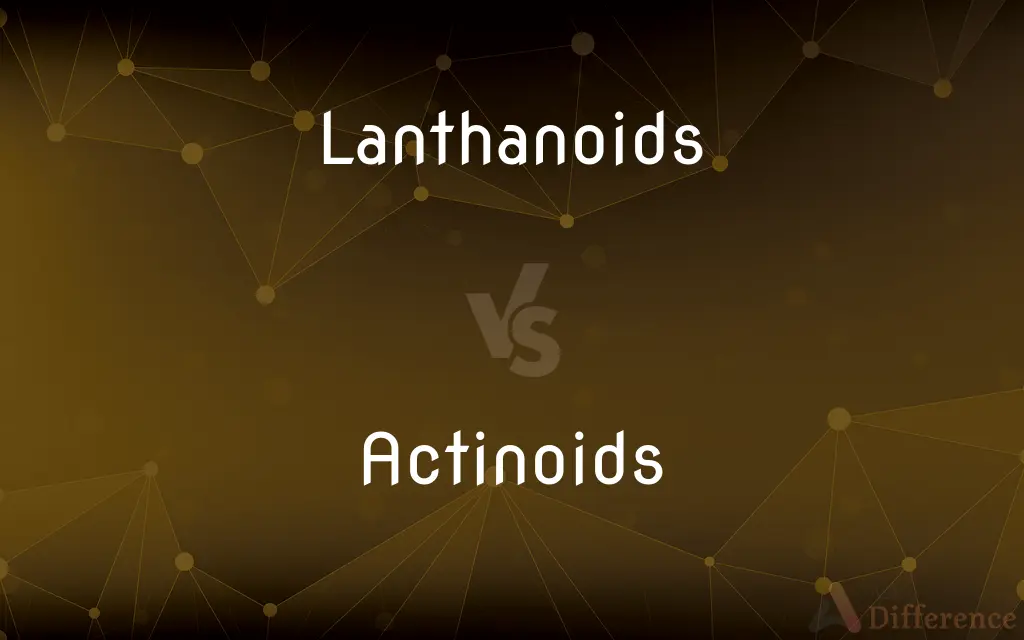Lanthanoids vs. Actinoids — What's the Difference?
By Tayyaba Rehman — Published on November 27, 2023
Lanthanoids are 15 metallic chemical elements with atomic numbers 57 through 71, while actinoids, also metallic, span atomic numbers 89 through 103, often characterized by their higher radioactivity.

Difference Between Lanthanoids and Actinoids
Table of Contents
ADVERTISEMENT
Key Differences
Lanthanoids, sometimes also termed lanthanides, showcase a series of 15 f-block elements starting with lanthanum (atomic number 57) and ending with lutetium (atomic number 71). Actinoids, alternatively spelled actinides, span a series of 15 elements too, commencing with actinium (atomic number 89) and concluding with lawrencium (atomic number 103). Both share the distinction of housing their valence electrons in f-orbitals, yet distinguish themselves by their position on the periodic table and ensuing chemical and physical properties.
The lanthanoids, known for their high ductility and malleability, exhibit metallic properties that make them useful in various industries, like the manufacturing of strong permanent magnets. The actinoids, notably denser and prominently more radioactive, demonstrate a dissimilarity, being extensively utilized in nuclear reactors due to their ability to sustain a nuclear fission chain reaction. The presence of f-electrons and ensuing magnetic characteristics further differentiate lanthanoids and actinoids in terms of their technological applications.
Embarking into the sphere of oxidation states, lanthanoids predominantly showcase a +3 oxidation state, with a few exceptions that can also exhibit +2 or +4 states. In stark contrast, actinoids display a larger variety of oxidation states, ranging from +3 to +7, attributed to their 5f, 6d, and 7s electrons participating in bonding. This differential oxidation behavior underscores a pivotal variation between lanthanoids and actinoids in their chemical interactions and stability.
Lanthanoids, often found in nature and commonly extracted from minerals like monazite and bastnasite, are relatively stable and can be isolated for use in various applications. Actinoids, displaying significant radioactivity, are often artificially synthesized, with only thorium and uranium being abundant in nature. This fundamental difference concerning their natural availability and synthetic production further punctuates the disparity in the practical and safety aspects related to lanthanoids and actinoids.
Concerning their applications in medicine and technology, lanthanoids, exemplified by gadolinium, find utility in magnetic resonance imaging (MRI) due to their notable magnetic properties. Actinoids, symbolized by plutonium and uranium, are primarily harnessed for their radioactive attributes in nuclear reactors and weapons. Consequently, lanthanoids and actinoids, with their discrete attributes, navigate divergent trajectories in technological, medicinal, and military applications.
ADVERTISEMENT
Comparison Chart
Atomic Numbers
57 through 71
89 through 103
Common Oxidation State
+3
Vary from +3 to +7
Abundance
Found in nature
Mostly synthetic
Radioactivity
Generally low
Typically high
Typical Use
Magnets, catalysts, lighting
Nuclear fuel, radiography
Compare with Definitions
Lanthanoids
+3 Oxidation State
Lanthanoids generally exhibit a +3 oxidation state, influencing their chemical stability.
Actinoids
Highly Radioactive
Actinoids, like uranium, are highly radioactive, fueling nuclear reactors.
Lanthanoids
F-Block Elements
Lanthanoids reside in the f-block of the periodic table, contributing to electronic industries.
Actinoids
Variable Oxidation States
Actinoids showcase a range of oxidation states, impacting their chemical reactivity.
Lanthanoids
Metallic Elements
Lanthanoids, such as neodymium, are used in manufacturing powerful magnets.
Actinoids
Used in Nuclear Reactions
Actinoids, notably plutonium, are key elements in sustaining nuclear fission.
Lanthanoids
Magnetic Properties
Lanthanoids are harnessed for their magnetic properties in medical imaging technologies.
Actinoids
Includes Synthetic Elements
Many actinoids, like nobelium, are synthetic and not found naturally.
Lanthanoids
Natural Abundance
Lanthanoids like lanthanum are relatively abundant and utilized in catalysis.
Actinoids
Dense Metallic Elements
Actinoids exhibit high densities, leading to applications in radiation shielding.
Lanthanoids
See lanthanide.
Actinoids
Plural of actinoid
Lanthanoids
Plural of lanthanoid
Common Curiosities
What characterizes actinoids?
Actinoids are 15 metallic elements, atomic numbers 89-103, notable for their radioactivity and use in nuclear technology.
Can actinoids fuel nuclear reactors?
Yes, actinoids like uranium and plutonium are pivotal in nuclear reactors.
Why are actinoids often synthesized?
Actinoids are often synthesized due to their high radioactivity and instability.
Is uranium a lanthanoid?
No, uranium, with atomic number 92, is an actinoid.
Do lanthanoids have varied oxidation states?
Lanthanoids primarily exhibit a +3 oxidation state, with few variations.
Is neodymium a part of the actinoid series?
No, neodymium, atomic number 60, is a lanthanoid.
Which series is utilized in magnet manufacturing?
The lanthanoid series is commonly used in magnet manufacturing.
Are actinoids used in medical imaging?
Actinoids are typically not used in medical imaging, which contrasts with some lanthanoids.
What are lanthanoids?
Lanthanoids are 15 metallic elements with atomic numbers 57-71, commonly used in technology and industry.
Are actinoids naturally abundant?
Mostly not, with the exception of uranium and thorium, actinoids are often scarce or synthetic.
What is a notable use of lanthanoids in medicine?
Lanthanoids like gadolinium are used in MRI due to their magnetic properties.
Is plutonium a lanthanoid?
No, plutonium, atomic number 94, belongs to the actinoids.
Do lanthanoids exhibit radioactivity?
Lanthanoids generally showcase minimal radioactivity compared to actinoids.
What is a prevalent feature of actinoids?
A prominent feature of actinoids is their high radioactivity and use in nuclear applications.
Can lanthanoids sustain a nuclear chain reaction?
Lanthanoids generally do not sustain nuclear chain reactions, a characteristic of some actinoids.
Share Your Discovery

Previous Comparison
DVD R vs. DVD RW
Next Comparison
Corn Flour vs. ArrowrootAuthor Spotlight
Written by
Tayyaba RehmanTayyaba Rehman is a distinguished writer, currently serving as a primary contributor to askdifference.com. As a researcher in semantics and etymology, Tayyaba's passion for the complexity of languages and their distinctions has found a perfect home on the platform. Tayyaba delves into the intricacies of language, distinguishing between commonly confused words and phrases, thereby providing clarity for readers worldwide.
















































